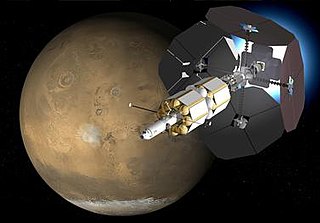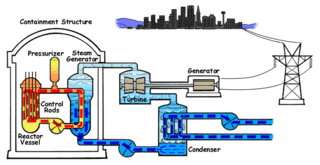
Spacecraft propulsion is any method used to accelerate spacecraft and artificial satellites. In-space propulsion exclusively deals with propulsion systems used in the vacuum of space and should not be confused with space launch or atmospheric entry.
A monopropellant rocket is a rocket that uses a single chemical as its propellant. Monopropellant rockets are commonly used as small attitude and trajectory control rockets in satellites, rocket upper stages, manned spacecraft, and spaceplanes.

A nuclear thermal rocket (NTR) is a type of thermal rocket where the heat from a nuclear reaction replaces the chemical energy of the propellants in a chemical rocket. In an NTR, a working fluid, usually liquid hydrogen, is heated to a high temperature in a nuclear reactor and then expands through a rocket nozzle to create thrust. The external nuclear heat source theoretically allows a higher effective exhaust velocity and is expected to double or triple payload capacity compared to chemical propellants that store energy internally.
A nuclear electric rocket is a type of spacecraft propulsion system where thermal energy from a nuclear reactor is converted to electrical energy, which is used to drive an ion thruster or other electrical spacecraft propulsion technology. The nuclear electric rocket terminology is slightly inconsistent, as technically the "rocket" part of the propulsion system is non-nuclear and could also be driven by solar panels. This is in contrast with a nuclear thermal rocket, which directly uses reactor heat to add energy to a working fluid, which is then expelled out of a rocket nozzle.
Beam-powered propulsion, also known as directed energy propulsion, is a class of aircraft or spacecraft propulsion that uses energy beamed to the spacecraft from a remote power plant to provide energy. The beam is typically either a microwave or a laser beam, and it is either pulsed or continuous. A continuous beam lends itself to thermal rockets, photonic thrusters, and light sails. In contrast, a pulsed beam lends itself to ablative thrusters and pulse detonation engines.

An antimatter rocket is a proposed class of rockets that use antimatter as their power source. There are several designs that attempt to accomplish this goal. The advantage to this class of rocket is that a large fraction of the rest mass of a matter/antimatter mixture may be converted to energy, allowing antimatter rockets to have a far higher energy density and specific impulse than any other proposed class of rocket.

The Variable Specific Impulse Magnetoplasma Rocket (VASIMR) is an electrothermal thruster under development for possible use in spacecraft propulsion. It uses radio waves to ionize and heat an inert propellant, forming a plasma, then a magnetic field to confine and accelerate the expanding plasma, generating thrust. It is a plasma propulsion engine, one of several types of spacecraft electric propulsion systems.

Nuclear pulse propulsion or external pulsed plasma propulsion is a hypothetical method of spacecraft propulsion that uses nuclear explosions for thrust. It originated as Project Orion with support from DARPA, after a suggestion by Stanislaw Ulam in 1947. Newer designs using inertial confinement fusion have been the baseline for most later designs, including Project Daedalus and Project Longshot.
A solar thermal rocket is a theoretical spacecraft propulsion system that would make use of solar power to directly heat reaction mass, and therefore would not require an electrical generator, like most other forms of solar-powered propulsion do. The rocket would only have to carry the means of capturing solar energy, such as concentrators and mirrors. The heated propellant would be fed through a conventional rocket nozzle to produce thrust. Its engine thrust would be directly related to the surface area of the solar collector and to the local intensity of the solar radiation.

Nuclear propulsion includes a wide variety of propulsion methods that use some form of nuclear reaction as their primary power source. The idea of using nuclear material for propulsion dates back to the beginning of the 20th century. In 1903 it was hypothesized that radioactive material, radium, might be a suitable fuel for engines to propel cars, planes, and boats. H. G. Wells picked up this idea in his 1914 fiction work The World Set Free. Many aircraft carriers and submarines currently use uranium fueled nuclear reactors that can provide propulsion for long periods without refueling. There are also applications in the space sector with nuclear thermal and nuclear electric engines which could be more efficient than conventional rocket engines.

Laser propulsion is a form of beam-powered propulsion where the energy source is a remote laser system and separate from the reaction mass. This form of propulsion differs from a conventional chemical rocket where both energy and reaction mass come from the solid or liquid propellants carried on board the vehicle.

Project Prometheus was established in 2003 by NASA to develop nuclear-powered systems for long-duration space missions. This was NASA's first serious foray into nuclear spacecraft propulsion since the cancellation of the SNTP project in 1995. The project was planned to design, develop, and fly multiple deep space missions to the outer planets.

The Nuclear Engine for Rocket Vehicle Application was a nuclear thermal rocket engine development program that ran for roughly two decades. Its principal objective was to "establish a technology base for nuclear rocket engine systems to be utilized in the design and development of propulsion systems for space mission application". It was a joint effort of the Atomic Energy Commission (AEC) and the National Aeronautics and Space Administration (NASA), and was managed by the Space Nuclear Propulsion Office (SNPO) until the program ended in January 1973. SNPO was led by NASA's Harold Finger and AEC's Milton Klein.
A radioisotope rocket or radioisotope thermal rocket is a type of thermal rocket engine that uses the heat generated by the decay of radioactive elements to heat a working fluid, which is then exhausted through a rocket nozzle to produce thrust. They are similar in nature to nuclear thermal rockets such as NERVA, but are considerably simpler and often have no moving parts. Alternatively, radioisotopes may be used in a radioisotope electric rocket, in which energy from nuclear decay is used to generate the electricity used to power an electric propulsion system.
The fission-fragment rocket is a rocket engine design that directly harnesses hot nuclear fission products for thrust, as opposed to using a separate fluid as working mass. The design can, in theory, produce very high specific impulse while still being well within the abilities of current technologies.

Spacecraft electric propulsion is a type of spacecraft propulsion technique that uses electrostatic or electromagnetic fields to accelerate mass to high speed and thus generating thrust to modify the velocity of a spacecraft in orbit. The propulsion system is controlled by power electronics.
Gas core reactor rockets are a conceptual type of rocket that is propelled by the exhausted coolant of a gaseous fission reactor. The nuclear fission reactor core may be either a gas or plasma. They may be capable of creating specific impulses of 3,000–5,000 s and thrust which is enough for relatively fast interplanetary travel. Heat transfer to the working fluid (propellant) is by thermal radiation, mostly in the ultraviolet, given off by the fission gas at a working temperature of around 25,000 °C.
A thermal rocket is a rocket engine that uses a propellant that is externally heated before being passed through a nozzle to produce thrust, as opposed to being internally heated by a redox (combustion) reaction as in a chemical rocket.

Direct Fusion Drive (DFD) is a conceptual, low radioactivity, nuclear-fusion rocket engine, designed to produce both thrust and electric power, suitable for interplanetary spacecraft. The concept is based on the Princeton field-reversed configuration reactor, invented in 2002 by Samuel A. Cohen. It is being modeled and experimentally tested at Princeton Plasma Physics Laboratory, a U.S. Department of Energy facility, as well as modeled and evaluated by Princeton Satellite Systems (PSS). As of 2018, a direct fusion drive project driven by NASA is said to have entered its simulation phase, presented as the second phase of the concept's evolution.
The Helical engine is a proposed spacecraft propulsion drive that, like other reactionless drives, would violate the laws of physics.











